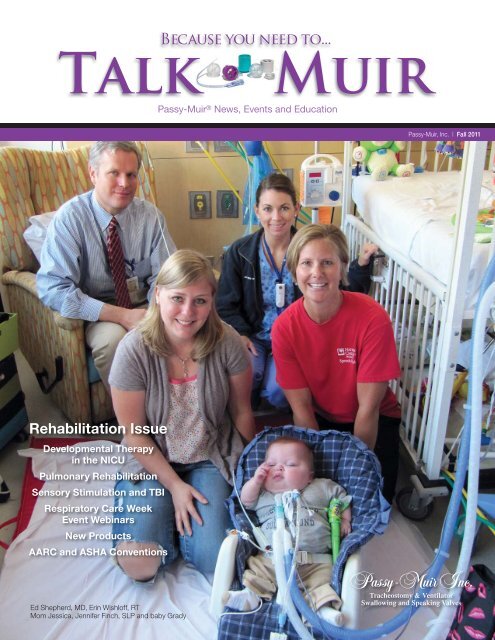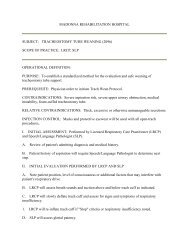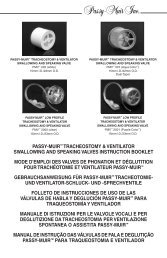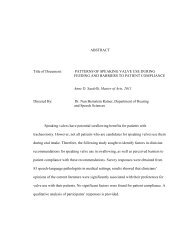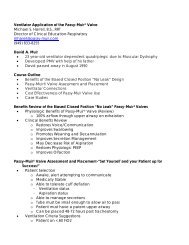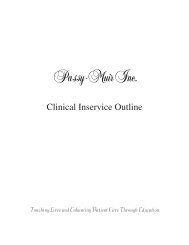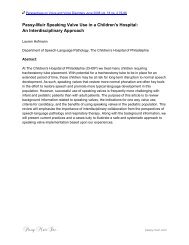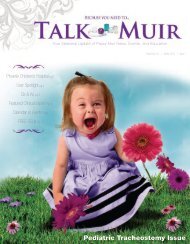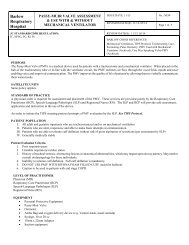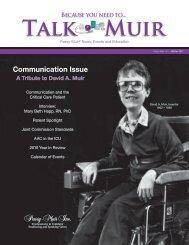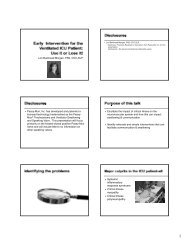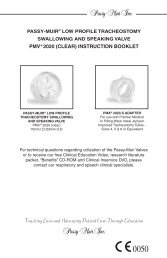Rehabilitation Issue - Passy-Muir
Rehabilitation Issue - Passy-Muir
Rehabilitation Issue - Passy-Muir
- No tags were found...
You also want an ePaper? Increase the reach of your titles
YUMPU automatically turns print PDFs into web optimized ePapers that Google loves.
<strong>Passy</strong>-<strong>Muir</strong> ® News, Events and Education<strong>Passy</strong>-<strong>Muir</strong>, Inc. | Fall 2011<strong>Rehabilitation</strong> <strong>Issue</strong>Developmental Therapyin the NICUPulmonary <strong>Rehabilitation</strong>Sensory Stimulation and TBIRespiratory Care WeekEvent WebinarsNew ProductsAARC and ASHA ConventionsEd Shepherd, MD, Erin Wishloff, RTMom Jessica, Jennifer Finch, SLP and baby Grady
2AbigailSebastian<strong>Passy</strong>-<strong>Muir</strong>, Inc. | Fall 2011<strong>Rehabilitation</strong> <strong>Issue</strong>The <strong>Passy</strong>-<strong>Muir</strong> ® Valve plays a verycritical role in the rehabilitation oftracheostomy and ventilator patientsof all ages across the continuum ofcare. You are probably aware of theimportance of the valve for communicationand swallowing rehabilitation.However, you might not be as familiarwith the many pulmonary andphysical rehabilitation benefi ts thatthe <strong>Passy</strong>-<strong>Muir</strong> Valve provides. In thisissue, you will learn that beginningin the intensive care unit, the valve isan essential component for achievingthe multiple and complex rehabilitationgoals of tracheostomy andventilator patients. Clinicians whounderstand the importance of themultidisciplinary team share theirstrategies for successful rehabilitationin this newsletter and at the 2011 AARCand ASHA National Conventions. Join<strong>Passy</strong>-<strong>Muir</strong> for special event livewebinars in celebration of RespiratoryCare Week this October and learnmore about the <strong>Passy</strong>-<strong>Muir</strong> Valveand <strong>Rehabilitation</strong>.Did you KNOW?Patients in intensive care canlose about 2% of muscle massa day during their illness.The <strong>Passy</strong>-<strong>Muir</strong> ® Valvecan be used as soon as48 hours post tracheostomy.Source: Griffi th, et al. 1999Pulmonary <strong>Rehabilitation</strong> Begins in the ICUBy Gail Sudderth, RRT, Clinical Specialist, <strong>Passy</strong>-<strong>Muir</strong>, Inc.Mary Spremulli, MA, CCC-SLP, Clinical Consultant, <strong>Passy</strong>-<strong>Muir</strong>, Inc.When the term “pulmonary rehab” is mentioned, most practicinghealthcare practitioners conjure up images of patients performing sixminute walks, exercise while seated using an arm cycle, or laps walkingon a track hooked up to an oxygen saturation and heart rate monitor.While this description may generally be true, it applies to patients whohave already recovered, maybe even to the point where they have beendischarged to home and are traveling to a facility for pulmonary rehab.What about pulmonary rehab for patients in the hospital or in ICU?Recently, much has been written about early mobilization of patients inthe ICU, not just range of motion and exercising while remaining in bedor standing at the bedside. Although more study needs to be done in thisarea, there appears to be a correlation between earlier mobilization ofpatients and improved outcomes. To take this a step further, what aboutstable tracheostomized and/or mechanically ventilated patients in thehospital or the ICU? Can they participate in pulmonary rehabilitation andearly mobilization? Of course, the answer is YES! The patient with atracheostomy both on and off mechanical ventilation can achieve the samebenefi ts as any other patient. There are some things to consider however,including coordination of therapies, especially between the respiratory carepractitioner (RCP) and the speech language pathologist (SLP).Atrophy of the muscles, including those of respiration and swallow, occursrapidly during times of critical care illness. Standing, walking, turning inbed, talking and even singing uses many muscle groups that interactconstantly, and the loss of coordination of these muscles may beeven more pronounced during times of illness. Therefore, strategies forstrengthening the respiratory muscles should be incorporated into theoverall therapy plan in the ICU, beginning as soon as the patient is ableto tolerate cuff defl ation and even before attempting standing or walking.Tasks such as speaking, coughing, and breath-holding involve use ofmuscles of both the upper and lower airway. Early use and rehabilitationof these muscles by performing expiratory muscle training exercises mayimprove endurance and exercise tolerance, which could in turn impactweaning from mechanical ventilation and decannulation.The placement of the tracheostomy tube with an infl ated cuff creates a“disconnect” between the upper and lower airways, bypassing the normalmechanisms that create and maintain positive airway pressure in thelungs. Because of this, patients with tracheostomy may fi nd it harder toperform exercise even for very short periods or become short of breatheasily. By achieving full cuff defl ation along with the use of the <strong>Passy</strong>-<strong>Muir</strong> ®Valve, a more normal closed aero-digestive physiology is restoredincluding airfl ow and positive airway pressure. Now, the therapist can
3AltheaPMV ® 2001 (Purple Color)include many of the therapies prescribed in the plan asthey would for any “pulmonary rehab” patient includingpatients who still require mechanical ventilation. Forpatients with tracheostomy to be successful, a dedicatedteam approach by the RCP and the SLP assures thatsynchronous and adequate ventilation is maintainedduring the therapy sessions.The following list of therapies can be performed bytracheostomized and ventilator dependent patientsutilizing a mouth piece or mouth seal in conjunction withthe <strong>Passy</strong>-<strong>Muir</strong> Valve. While some of these therapiesmay be prescribed primarily as an adjunct to bronchopulmonaryhygiene (airway clearance) regimens or for lungexpansion, therapies that provide expiratory resistancehave also been reported to strengthen the muscles ofrespiration and improve overall strength and duration ofexercise.Respiratory muscle training while using the <strong>Passy</strong>-<strong>Muir</strong>Valve can include:Instruction in diaphragmatic breathing and pursedlip breathingThe two pictures above:Therapists at Madonna <strong>Rehabilitation</strong> Hospital in Lincoln, NEusing expiratory muscle training devices with ventilator patients.Expiratory muscle training using adevice such as• EMST 150• Threshold PEPTherapies to assist in lung expansion coughing andairway clearance• Acapella• EZ Pap• The BreatherSapienza, M., & Wheeler, K. (2006). Respiratory muscle strengthtraining: Functional outcomes versus plasticity. Seminars in Speechand Language for a special edition called New Frontiers in Dysphagia<strong>Rehabilitation</strong>, 27( 4): 236-244.Clinical team at Kindred Hospital, Wilkes-Barre, PAambulating a ventilator patient using the PMV ® 007.Pitts, T., et. al. (2009). Impact of expiratory muscle strength trainingon voluntary cough and swallow function in Parkinson disease.Chest, 135: 1301-1308.Baker, S. et. al. (2005). Examination of strength training and detrainingeffects in expiratory muscles. J Speech Lang Hear Res, 48: 1325-1333.
4ArturoPMV ® 2000 (clear)<strong>Passy</strong>-<strong>Muir</strong>, Inc. | Fall 2011Facility SpotlightBy Julie Kobak, MA, CCC-SLP, Vice President of Clinical Education, <strong>Passy</strong>-<strong>Muir</strong>, Inc.Nationwide Children’s Hospital – Advancing Developmental Outcomes in the NICURanked by U.S. News & World Reportin 2010 as one of “America’s Best Children’s Hospitals,”Nationwide Children’s Hospital in Columbus, Ohio hasalways had a very strong focus and commitment tothe developmental needs of their pediatric patients. Inparticular, the speech-language pathologists provideearly intervention to address communication and verbaldevelopment for even the youngest and most criticalpatients in the NICU. Although they would routinely assessfor and place <strong>Passy</strong>-<strong>Muir</strong> ® Swallowingand Speaking valves on babies whohave a tracheostomy tube when off ofthe ventilator, they rarely used thevalve with infants and children stilldependent on the ventilator, andtherefore were not able to access allaspects of their development.In 2008, speech-language pathologists Melanie Stevens,MS, CCC-SLP and Jennifer Finch, MA, CCC-SLP, teamedup with the physicians, respiratory therapists and the ENTnurse practitioner to develop a standard and coordinatedprotocol for <strong>Passy</strong>-<strong>Muir</strong> Valve use with ventilator patientsin their NICU Bronchopulmonary Dysplasia (BPD) unit.The protocol which was formalized in 2010 providesconsistent patient selection parameters for <strong>Passy</strong>-<strong>Muir</strong>Valve assessment, outlines multi-disciplinary teammember roles, and gives guidelines for the progressionof <strong>Passy</strong>-<strong>Muir</strong> Valve wearing time. With use of this newprotocol, all children with tracheostomies are assessedas soon as 7 days post tracheostomy when they aremedically stable and tolerating cuffdefl ation. The protocol is inclusiveof children who are ventilatordependent, even those on fullventilator support.PMV ® 007 (Aqua Color)I had the opportunity to meet the team and one of theirpatients on a recent visit to the hospital. I joined speechlanguagepathologist, Jennifer Finch, for her therapy sessionwith Grady, a 16 month old who was born prematurewith Grade III and IV intraventricular hemorrhages and asevere case of BPD. He had been hospitalized and ventilatordependent since birth in a hospital in another statebut his parents transferred him to Nationwide Hospitalbecause of its exceptional developmental program andBPD ventilator weaning program.“We’re believers!As we entered Grady’s room, he wasreclined in his portable highchairWe’ve quickly learned thatvocalizing loudly to his mom. We wereyou cannot neglect language joined shortly by his neonatologist, Dr.development while trying to Shepherd, who stopped by to meet merescue them from lung disease.” and tell me more about the <strong>Passy</strong>-<strong>Muir</strong>protocol development. First, Jenniferexplained that it was important to theteam to “have consistency with the referral process”. Shesaid that through the use of objective guidelines they areable to identify the children who were valve candidatesearlier and more clearly. Although there are specifi cventilator parameters and transtracheal pressures aspart of their criteria, she cautioned that these parametersare guidelines only. For example, Grady was well abovetheir assessment criteria for both ventilation and transtrachealpressure, but he clearly demonstrated othersigns that he was a good candidate for the <strong>Passy</strong>-<strong>Muir</strong>Valve. He was leaking air around his uncuffed tracheostomytube and had some occasional vocalization. Because ofGrady’s high ventilating pressures, Dr. Shepherd said,“For children like Grady, our initial concerns were that itwould make their work of breathing worse or that it wouldmake them less successful on their CPAP/pressuresupport trials. But it hasn’t worked out that way in theleast. They do not have negative consequences havingPMVs in place. We think we have been able to adddevelopmental progress with little expense, which hasbeen great.”
5SydneyPatriciaJennifer Finch, MA, CCC-SLP providingdevelopmental speech and language therapy to Grady.Nationwide Children’s Hospital clinicians (L to R)Jennifer Finch, MA, CCC-SLP, Leslie Justice, RN, MS, CPNP,and Melanie Stevens, MS, CCC-SLPIt was obvious that the team at Nationwide is excitedabout the results of their new protocol. The protocol alongwith the increased multidisciplinary team interaction hasled to an increase in referrals for assessment and useof the <strong>Passy</strong>-<strong>Muir</strong> Valves as well as improved quality ofpatient care and developmental outcomes. Grady isbeginning oral motor feeding therapy while using the<strong>Passy</strong>-<strong>Muir</strong> Valve and enjoying his fi rst tastes of sweetpotatoes and apple juice.Grady, using the PMV ® 007 makes sounds with mom, Jessica.Grady, whose peak airway pressures range from 55 to60cm H 2 O, uses the PMV ® 007 in-line with his ventilatorduring all waking hours. Grady’s mom was unable to hearGrady vocalize and cry until he was 13 months old,when the valve was placed shortly after his admission toNationwide. She stated, “It has been a blessing to me tohear him speak. Sometimes I can hear him all the wayfrom the nurse’s station!”Dr. Shepherd summarized the team’s sentiments abouttheir <strong>Passy</strong>-<strong>Muir</strong> Valve protocol, “We’re believers! We’vequickly learned that you cannot neglect language developmentwhile trying to rescue them from lung disease.You have to proceed with teaching them language andhow to talk even when they are on signifi cant ventilatorsupport.”You can learn more about the Nationwide Protocol byvisiting their poster session at the 2011 ASHA Conventionor by reading their article which will be published in theDecember issue of Neonatal Intensive Care.See page 11 for details.Scan here to watch a video of Grady and theteam from Nationwide Children’s Hospital.Or visit: http://tinyurl.com/pmv-nwc
KayleenSarahCommunication from Both Sides of the Bedrail:Insight from a Respiratory Care PractitionerInterviewed by Gail Sudderth, RRT, Clinical Specialist, <strong>Passy</strong>-<strong>Muir</strong>, Inc.Ashley Oliver woke up from a medically induced coma one month following anautomobile crash that almost took her life. Fortunately, she has since made a completerecovery and is now a student at University of Alabama at Birmingham, pursuingher BS in Respiratory Therapy. Ms. Oliver shares her unique perspective on what it is liketo be a patient with a tracheostomy and unable to communicate.“My fi rst memories were waking up in a step-downunit and having no recollection of the accident orwhat had happened to me. I remember now feelingvery sad when I thought I would never speak again.Soon, I fi gured out that if I pushed on my cervicalcollar and occluded the tracheostomy tube, a faintvoice would come out. Then I was told that I wouldn’tneed the collar anymore. Being thankful my life hadbeen spared, I soon just accepted that I would haveto use one of those voice boxes the rest of my life tospeak. I tried to accept my fate; however, it was noteasy at the time.One day, Brad Shivers RCP, came in and told me hehad a little cap, which was actually the <strong>Passy</strong>-<strong>Muir</strong> ®Valve, that I could put on my tracheostomy tube sothat I could talk!! It wasn’t easy at fi rst, but I was soexcited to be able to speak again. It wasn’tlong before my tracheostomy was removedand I was able to start rehab and go home.What I hope to share with others is a veryunique perspective of the tracheostomizedpatient since I have been where they are,and now I am the caregiver. We don’t realizethat the average person does not fullyunderstand what a tracheotomy is, letalone the long term implications. Not beingunderstood was probably one of the mostdiffi cult obstacles I had to overcome whilein the ICU.6 6<strong>Passy</strong>-<strong>Muir</strong>, Inc. | Fall 2011Ashley OliverAs the caregiver, reading lips or hand gestures is verydiffi cult. We may just smile and nod, tell them, “relax,it will be OK, I will come see you later,” as we areleaving them. We don’t mean to, and even though it isunintentional, it is neglect. Imagine how the patient mustfeel as we walk away.Although we may all be guilty of making assumptions,not all trach patients are hard of hearing or sufferfrom brain damage. I now sympathize so much with mytrach patients and their families. I am often called to apatient’s room to read lips in the initial stages followingthe tracheostomy, since I have experience. My favoritepart is then being able to share my personal experiencewith the patient, and their family and friends. I tellthem, “Believe it or not, a trach is not the worst thing,”which seems to reassure the patient and the uneasyrelatives. We strike up an instant friendshipand they no longer seem so terrifi ed of theidea of the tracheotomy. Let’s be honest, a holein your throat does not sound very enticing.We all must remember how importantthe ability to communicate is for all of ourpatients, not only with family and friends, butwith their healthcare providers as well. The<strong>Passy</strong>-<strong>Muir</strong> speaking valve is an innovativeand easy way to greatly improve a patient’squality of life by giving them back their abilityto speak.”Photos by Dr. Wes Granger. Used with permission.
7PMV ® 2001 (Purple Colorwith PMA ® 2000 AdapterDeniseAsk the Clinical SpecialistBy Mike Harrell, RRT, Director of Clinical Education - Respiratory, <strong>Passy</strong>-<strong>Muir</strong>, Inc.Question: How early in recovery from traumatic brain injury can a <strong>Passy</strong>-<strong>Muir</strong> ® Valve be used?Assessment of cognitive function begins very early inpatients with severe traumatic brain injury, often as soonas patients begin emerging from a deep coma (1-3). TheRappaport Coma/Near Coma Scale is a standardizedassessment tool that scores a patient’s responses tovarious stimuli across all sensory domains (1). A patient’sability to vocalize or verbalize is a signifi cant factor in thisassessment. Responses to strong odors, visual, tactileand painful stimuli are also rated. An open tracheostomytube does not allow airfl ow through the oral and nasaltract for olfaction nor does it allow the patient the abilityto vocalize or verbalize a response. Therefore, for sometracheostomy patients, the total score of this scalecan be altered, and therapeutic plans based on theassessment can be misguided. Use of the <strong>Passy</strong>-<strong>Muir</strong> ®Valve can begin as soon as 48 hours after the originalplacement of the tracheotomy tube. Early placement ofthe <strong>Passy</strong>-<strong>Muir</strong> Valve can restore airfl ow to the upperairway allowing increased vocalizations and awarenessof sensory stimulation, thus providing more completeand meaningful assessment and ultimately hasteningrecovery to the highest possible function.physiologic expiration.” For patients not ready for decannulation,cuff defl ation and early use of the <strong>Passy</strong>-<strong>Muir</strong> ®Valve can signifi cantly contribute to the improvement ofswallow safety and effi cacy by not only restoring expiratoryairfl ow physiology, but also reestablishing the benefi ts ofsubglottic pressure (5).To see a visual representation of the physiologic benefi tsof the closed position function of the <strong>Passy</strong>-<strong>Muir</strong> ® Valve,please visit our website at:www.passy-muir.com/education/benefits/video.aspx.The presence of a tracheostomy tube with an infl ated cuffhas signifi cant effects on swallowing frequency andeffectiveness due to decreased laryngeal excursion,subglottic pressure and oropharyngeal sensitivity (4-6).In a study by Dr. Seidl and colleagues (4), tracheostomytubes were determined to decisively infl uence theswallowing behavior of vegetative patients. For patientswith a Glasgow Coma Scale score below 8 points,the presence of the tracheotomy tube decreased theswallowing frequency. Removal of the tracheostomytube signifi cantly improved swallowing frequency for thisgroup of patients. Therefore, the authors recommenddefl ation of the cuff or removal of the tracheostomy tubeas a therapeutic measure to improve swallow functionbased on “improved sensitivity under reestablished1. Rappaport, M. (2005). The Disability Rating Scale and Coma/Near Coma Scales in evaluating severe head injury. Neuropsychological<strong>Rehabilitation</strong>, 15(3/4): 442-443.2. Rappaport, M., Dogherty, A., & Kelting, D. (1992). Evaluation ofcoma and vegetative states. Archives of Physical Medicine and <strong>Rehabilitation</strong>,73:628-634.3. Talbot, L., & Whitaker, H. (1994). Brain injured persons in an alteredstate of consciousness: Measures and intervention strategies. BrainInjury, 8:689-699.4. Seidl, R., et. al. (2005). The infl uence of tracheostomy tubes onthe swallowing frequency in neurogenic dysphagia. OtolaryngologyHead Neck Surgery, 132:484-486.5. Eibling, D., & Gross, R. (1996). Subglottic air pressure: A keycomponent of swallowing effi ciency. Annals of Otology RhinologyLaryngology, 105:253-258.6. Dettelbach, M., Gross, R., Mahlmann, J., et. al. (1995). The effectof the <strong>Passy</strong>-<strong>Muir</strong> valve on aspiration in patients with tracheostomy.Head & Neck, 17:297-302.
8KylonToby Tracheasaurus<strong>Passy</strong>-<strong>Muir</strong>, Inc. | Fall 2011Featured Clinical Expert:The Role of the <strong>Passy</strong> <strong>Muir</strong> Valve inAdult and Pediatric <strong>Rehabilitation</strong>Rebecca Wills BA, CRT, CRT-NPS, PulmonaryProgram Manager at Madonna <strong>Rehabilitation</strong> Hospitalhas been a respiratory therapist since 1993 andreceived her Bachelor of Arts degree in Allied Healthcum laude in 2004 and her specialty designation inNeonatal/Pediatric Respiratory Care in 2009. On staff atMadonna <strong>Rehabilitation</strong> Hospital in Lincoln, Nebraskasince 1996, Rebecca is the Pulmonary Program Managerand is responsible for the development, growth, qualityand marketing of programs for adult and pediatrictracheostomy and ventilator patients.Does the placement of a tracheostomy tube havean impact on a patient’s physical functioning, forexample: trunk control, posture, and movement?Absolutely! The body is designed to be a closed system.The trunk includes the abdominal and thoracic cavities,separated by the diaphragm. The vocal folds and thepelvic fl oor create a closed “cylinder,” with the diaphragmregulating the pressure.Trunk control, breathing and internal functions aredependent on the ability of the body to generate, maintainand regulate pressure in the thoracic and abdominalcavities. Placement of a tracheostomy tube creates abreach in that closed system, and that changes everything.Rebecca WillsBA, CRT, CRT-NPSPulmonary ProgramManagerIn your experience, what benefit does a <strong>Passy</strong>-<strong>Muir</strong> ®Valve have on physical rehabilitation?The <strong>Passy</strong>-<strong>Muir</strong> ® Valve plays a vital role in the rehabilitationof adult and pediatric tracheostomy and ventilator patientsthroughout the continuum of care. Within 48 hours ofadmission at Madonna <strong>Rehabilitation</strong> Hospital, thespeech-language pathologists and respiratory therapistsassess each tracheostomy patient’s speech, voice andswallow. As part of our tracheostomy weaning protocol,an individualized treatment plan (ITP) is designed. Thisprotocol is utilized with all patients, including our medicallycomplex Long Term Acute Care Hospital (LTACH)ventilator patients.Communicating with family and caregivers is vital to apatient’s rehabilitation success. Use of the <strong>Passy</strong> <strong>Muir</strong>Valve restores the body’s closed system. The resultingpositive pressure allows for improved breath support andphonation, and louder, more natural voicing.Early use of the <strong>Passy</strong>-<strong>Muir</strong> Valve facilitates participationin and/or the ability to direct one’s own care, anothercore goal of rehabilitation.Patients typically rely on tracheal suction for secretionmanagement. Restoring an effective cough can reduceor eliminate the need for this invasive procedure. Aneffective cough requires adequate inspiratory volumeand expiratory fl ow. With the valve on, the respiratorytherapist can measure the patient’s Peak Expiratory Flow(PEF) using a peak fl ow meter, and incorporateexpiratory training devices and strategies to improvecough strength and quality.▲Erin Reier, OTD, OTRL/L facilitates increased breathing supportfor Dathin while he sings in therapy.
9LeezaAbigailMadonna’s interdisciplinary teams develop ITPs basedon research-supported strategies. For example, physicaltherapist and published researcher, Dr. Mary Massery,demonstrates the relationship between breathing andpostural control, and the need to treat them together inher course, “If You Can’t Breathe You Can’t Function”.The expertise of a rehabilitation team that incorporatesthese strategies with the <strong>Passy</strong> <strong>Muir</strong> Valve will allow everytracheostomy patient to maximize their potential andachieve the best possible outcome. Just ask some ofour patients.Shane, a 23 year old with paraplegia following a spinalcord injury, wanted to go home. His rehabilitation goalsincluded being independent in his transfers. With anopen tracheostomy, Shane was unable to generate andmaintain the internal pressures he needed to lift himselfinto his wheelchair. Use of the <strong>Passy</strong> <strong>Muir</strong> Valve restoredhis body’s closed system allowing Shane to quickly meethis goal.Dathin using the PMV ® 2001 while working onpelvic positioning and weight bearing activitiesLindsay Tuxhorn, OTD, OTR-L, teaches Jerredhow to use a voice-activated telephone receiver.Jeremy, an energetic 2 year old with multiple disabilitieshas had a tracheostomy tube since birth. One of Jeremy’sout-patient rehabilitation goals was to increase hisindependence through the use of a manual wheelchair.With an open tracheostomy, Jeremy did not have thetrunk control to sit upright without assistance and couldnot generate the internal pressure he needed to propelhis chair. Once the <strong>Passy</strong>-<strong>Muir</strong> Valve was introduced,Jeremy’s interdisciplinary team of therapists began tofocus on postural control and upper body strength andcoordination. Jeremy is now able to navigate and explorehis world like other 2 year olds.Jerred, a 37 year old who had a C4 spinal cord injury onAugust 7, 2011 was admitted to Madonna three weeksafter his injury. Ventilator dependent and unable to voicehis needs or communicate with his family, Jerred wasreliant on others to read his lips. Jerred’s speech therapistand respiratory therapist evaluated him for the use of the<strong>Passy</strong> <strong>Muir</strong> Valve within 48 hours of his admission. Withthe <strong>Passy</strong> <strong>Muir</strong> Valve, Jerred is now able to utilize voiceactivated technology, increasing his independence viahis computer. He also uses a voice activated phone sothat he can stay in touch with his 11 year old daughter,Taylor, who is at home in Iowa.To watch more patients at Madonna realizing theirrehabilitation outcomes with the <strong>Passy</strong>-<strong>Muir</strong> Valve visithttp://tinyurl.com/mrh-pmv or scan here.You can attend Rebecca’s presentation “Pulmonary Management of the Spinal Cord Injury Patient”at the AARC Congress 2011 on November 5th at 3:20pm.
10JackRose<strong>Passy</strong>-<strong>Muir</strong>, Inc. | Fall 2011Free Live Event WebinarsTracheostomy:Procedures, Timingand TubesSpeaker: Gail Sudderth, RRT,Clinical Specialist<strong>Passy</strong>-<strong>Muir</strong>, Inc.Offered at two different times:Monday, October 24th,12:00 pm or 3:00 pm ESTThe choice of the tracheostomy tube can have an impacton the evaluation and treatment of the tracheostomizedpatient, therefore, a description of the various tracheostomytubes, types of cuffs and proper cuff maintenance willbe given. Case studies will be used to demonstrate theimportance of selecting proper tube size and type, asit relates to upper airway assessment, swallowing, andcommunication options.<strong>Passy</strong>-<strong>Muir</strong> ValveFAQ ChallengeSpeakers:Mike Harrell, RRT,Director of Clinical Education-RT<strong>Passy</strong>-<strong>Muir</strong>, Inc.Gail Sudderth, RRT, Clinical Specialist, <strong>Passy</strong>-<strong>Muir</strong>, Inc.Offered at two different times:Tuesday, October 25th, 3:00 pm or 6:00 pm ESTUsing an interactive polling feature, attendees can testtheir knowledge of frequently asked questions related toairway assessment, choosing a <strong>Passy</strong>-<strong>Muir</strong> Valve, orderingand billing information, and treatment modalities appropriatefor use with the tracheostomized and ventilatordependent patient.<strong>Passy</strong>-<strong>Muir</strong>, Inc. is an approved provider of continuing education by the ContinuingRespiratory Care Education (CRCE) system of the American Association of RespiratoryCare (AARC), the Continuing Education Board of American Speech-Language-HearingAssociation (ASHA), and the California Board of Nursing.There’s More to Lifethan BreathingSpeakers:Linda Dean, RRT, Clinical Specialist<strong>Passy</strong>-<strong>Muir</strong>, Inc.Jack Rushton, ventilator userWednesday, October 26th, 3:00 pm ESTJoin us to learn about ventilator use from Jack Rushton,who has been using a <strong>Passy</strong>-<strong>Muir</strong> Valve with his ventilatorfor 22 years. Get information on in-line valve placementand making ventilator adjustments from Linda Dean, RRT.“Yes You Can!”Cardiopulmonary <strong>Rehabilitation</strong> for theTracheostomy and Ventilator PatientSpeaker: Linda Dean, RRTClinical Specialist, <strong>Passy</strong>-<strong>Muir</strong>, Inc.Offered at two different times:Thursday, October 27th,12:00 pm or 3:00 pm ESTCurrent research is showing thatearly ambulation for the criticalcare inpatient has many benefi ts, including decreasingICU length of stay by as much as 30%. In this webinar,clinicians will learn how a comprehensive team approachand pulmonary rehabilitation with early mobilization andexercise can impact length of stay, functional outcomesand quality of life for tracheostomy and ventilator patients.The role of the <strong>Passy</strong>-<strong>Muir</strong> Valve in early mobilization willbe discussed as it relates to the restoration of a closedrespiratory system and positive intra-thoracic pressure forpostural control, extremity force and utilization oftreatment strategies that require expiratory airfl owthrough the mouth. A case study by the rehabilitation teamof Kindred Hospital Wyoming Valley in Wilkes-Barre, PAwill be presented highlighting these concepts and theirsuccessful outcomes including a 13% improved weaningrate after just over one year of implementation.
11AngelaBrendaOctober4 Michigan Society for Respiratory Care Conference – Presentation6 National Association of Long Term Hospital (NALTH) – Exhibit6 Iowa Speech-Language Hearing Association Conference – Presentationtion8 Intermountain Speech and Hearing Conference – Presentation13 Washington Speech and Hearing Association Conference – Presentation28 West Tennessee Chapter Society for Respiratory Care Conference – Presentationn29 Weisman Children’s <strong>Rehabilitation</strong> Hospital, New Jersey – SeminarNovemberCalendar of Events4 Kindred Hospital of San Antonio Texas Regional Conference – Presentation5-8 American Association or Respiratory Care (AARC) National CongressTampa, FL – ExhibitPresentations:• Pulmonary Management of the Spinal Cord Injury PatientRebecca Wills, Lincoln, NE, Nov. 5, 3:20-4:05 pm17-19 American Speech and Hearing Association (ASHA) National ConventionnSan Diego, CA – ExhibitPresentations:• <strong>Passy</strong>-<strong>Muir</strong> FAQ Challenge, Exhibitor Learning Lab 1PMV ® 2001(Purple Color)Gail Sudderth, Nov. 18, 3:30-4:30 pm• Application of the <strong>Passy</strong>-<strong>Muir</strong> Tracheostomy and Ventilator Swallowing and Speaking ValveLinda Dean and Julie Kobak, Nov. 18, 5:00-6:00 pm• <strong>Passy</strong>-<strong>Muir</strong> Valve in the NICUMelanie Stevens and Jennifer Finch, Columbus OH, Nov. 19, 10:00-11:30 am• Initiating In-Line Ventilator Speaking Valve Protocols: Why and How?Kristin Dolan, Melbourne, FL, Nov. 19, 11:00 am-12:00 pmDecember6 Kindred Healthcare Clinical Impact Symposium 2011, Louisville, KY – Presentation tiandExhibitit
<strong>Passy</strong>-<strong>Muir</strong>, Inc. | Fall 2011PMB 273, 4521 Campus DriveIrvine, CA 92612David <strong>Muir</strong>InventorNEWProductsNOW AvailableTalk-<strong>Muir</strong> is published by <strong>Passy</strong>-<strong>Muir</strong>, Inc.for tracheostomy and ventilator-dependentpatients, their caregivers and medicalprofessionals in an effort to provide:Interesting news and storiesResources and clinical tipsInformation about new educationalopportunitiesUpcoming events and moreStory contributions and commentsare welcome.<strong>Passy</strong>-<strong>Muir</strong>, Inc.PMB 2734521 Campus DriveIrvine, CA 926121.800.634.5397info@passy-muir.comwww.passy-muir.com<strong>Passy</strong>-<strong>Muir</strong> Cleaning TabletsThe New Cleaning Tablets are made from a detergentused for other medical supplies because it leaves noresidue as do some commercially available soaps.• 30 Tablets• Biodegradable• Leaves No Residue • Convenient SizePatient Education HandoutsPrice: $ 6 99• Tear Sheets with colorful graphics andeasy-to-read instructions• Ideal for teaching tracheostomyconcepts and clinical benefi ts of the<strong>Passy</strong>-<strong>Muir</strong> ® Valve• Can be individualized for each patientand taken with them wherever they goEach tablet has 35 sheets,with 3 tablets per pack. 8.5”x11” size.Price: $ 0018To order visit store.passy-muir.comor call 1-800-634-5397


